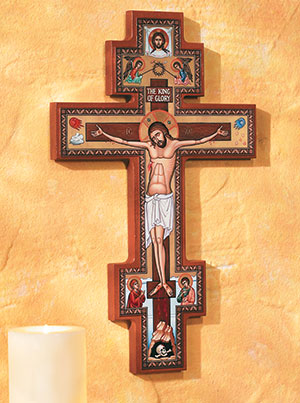
 “The same things that the Book of the Gospels explains by means of words, the painter shows by means of his works.”
“The same things that the Book of the Gospels explains by means of words, the painter shows by means of his works.”
—St. Basil the Great
An Eastern Orthodox bishop once described iconography as “theology in line and color.” The Byzantine Crucifix offered by Monastery Icons demonstrates this well.
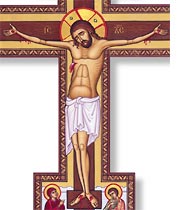 The most striking element of the Byzantine Crucifix is the figure of Christ. It is not the body of a corpse, but of God Himself, incorruptible unto eternity and the source of life, radiating the hope of the Resurrection. He does not hang on the Cross, but rather seems to be supporting it. His hands are not cramped from being nailed to the wood, but rather spread out serenely in an attitude of supplication, which the iconographer has further emphasized by Jesus’ tranquil and gentle expression. This icongraphic Crucifix does not express the brute horror of death by crucifixion, but rather the nobility and gentleness of eternal life.
The most striking element of the Byzantine Crucifix is the figure of Christ. It is not the body of a corpse, but of God Himself, incorruptible unto eternity and the source of life, radiating the hope of the Resurrection. He does not hang on the Cross, but rather seems to be supporting it. His hands are not cramped from being nailed to the wood, but rather spread out serenely in an attitude of supplication, which the iconographer has further emphasized by Jesus’ tranquil and gentle expression. This icongraphic Crucifix does not express the brute horror of death by crucifixion, but rather the nobility and gentleness of eternal life.
The figure of our Lord is itself instructive, for He stands upon the cross (the short crossbar beneath His feet was actually a kind of shelf). This indicates that our Lord suffered His passion voluntarily and was at all times the master of life and death. This is also shown by the calm expression on His face and the relaxed attitude of His body.
Sacred imagery from both the Scriptures and holy tradition fill this iconographic Byzantine Crucifix.
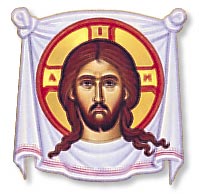 At the top of the Crucifix we see the Holy Napkin bearing the imprint of our Lord’s face. Tradition tells us that King Agabus of Syria, having heard of the Lord and His miracles and wishing to “see” Him, sent an artist to draw a likeness of Him. However much he tried, the artist could not capture the divine features of the Lord, Who in His compassion took a piece of cloth, pressed it to His face, and miraculously imprinted His likeness thereon. The artist then took this miraculous image to the king, who was cured of leprosy by its very touch. The Holy Napkin at the top of the crucifix thus reminds us of our Lord’s true descent into flesh and His omnipotent power.
At the top of the Crucifix we see the Holy Napkin bearing the imprint of our Lord’s face. Tradition tells us that King Agabus of Syria, having heard of the Lord and His miracles and wishing to “see” Him, sent an artist to draw a likeness of Him. However much he tried, the artist could not capture the divine features of the Lord, Who in His compassion took a piece of cloth, pressed it to His face, and miraculously imprinted His likeness thereon. The artist then took this miraculous image to the king, who was cured of leprosy by its very touch. The Holy Napkin at the top of the crucifix thus reminds us of our Lord’s true descent into flesh and His omnipotent power.
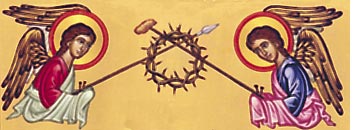 The angels below the Holy Napkin are holding the instruments of the Passion: the spear that pierced His side, and the vinegar-soaked sponge on a stick. In their hands they hold the nails of crucifixion. They first of all remind us of the depiction of the Virgin Mary
The angels below the Holy Napkin are holding the instruments of the Passion: the spear that pierced His side, and the vinegar-soaked sponge on a stick. In their hands they hold the nails of crucifixion. They first of all remind us of the depiction of the Virgin Mary 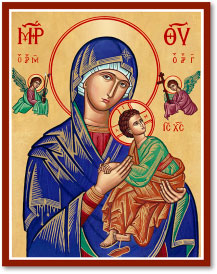 known as Our Lady of the Passion (and also Our Lady of Perpetual Help), in which two angels are showing the instruments of the Passion to the infant Christ, thus indicating that our Lord was conscious of His redemptive mission from the very first. They also indicate that the Passion of our Lord was the will of the Father, and so it is angels who hold the instruments of the Passion rather than men. In this way we are reminded that however much the malice of wicked men may have intent on our Lord’s crucifixion, it was truly the will of the Father, the “cup,” which He gave our Lord to drink.
known as Our Lady of the Passion (and also Our Lady of Perpetual Help), in which two angels are showing the instruments of the Passion to the infant Christ, thus indicating that our Lord was conscious of His redemptive mission from the very first. They also indicate that the Passion of our Lord was the will of the Father, and so it is angels who hold the instruments of the Passion rather than men. In this way we are reminded that however much the malice of wicked men may have intent on our Lord’s crucifixion, it was truly the will of the Father, the “cup,” which He gave our Lord to drink.
Rather than “Jesus of Nazareth, the King of the Jews” 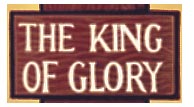 (INRI), which was written in derision (or unconscious confession) by Pilate, we see the words “The King of Glory,” indicative of His divine kingdom. This expression is found in the Book of Acts, when Saint Peter tells the elders of Israel that they crucified the king of glory. On the major crossbar of the Crucifix we find the letters ICXC, which are abbreviations for the words “Jesus Christ”–that is, Jesus the Messiah.
(INRI), which was written in derision (or unconscious confession) by Pilate, we see the words “The King of Glory,” indicative of His divine kingdom. This expression is found in the Book of Acts, when Saint Peter tells the elders of Israel that they crucified the king of glory. On the major crossbar of the Crucifix we find the letters ICXC, which are abbreviations for the words “Jesus Christ”–that is, Jesus the Messiah.
And at the two ends of the crossbar we find the sun at our Lord’s right hand and the moon and stars at our Lord’s left hand, reminding us that they hid their faces behind the clouds and refused to give their light when they beheld the King of Glory crucified between two thieves and mocked by sinful men.
 “Darkness was over the land from the sixth to the ninth hour, and the sun was darkened.” Even the face of nature mourns the suffering and death of the Incarnate God, as our iconographer has shown in the personified Sun and Moon who look upon Christ from the ends of the main crossbar of the Crucifix.
“Darkness was over the land from the sixth to the ninth hour, and the sun was darkened.” Even the face of nature mourns the suffering and death of the Incarnate God, as our iconographer has shown in the personified Sun and Moon who look upon Christ from the ends of the main crossbar of the Crucifix.
 The Holy Virgin and Saint John the Evangelist stand at the foot of the cross–”His Mother and the disciple whom He loved.” In the background we see the walls and buildings of Jerusalem to remind us that Christ “suffered without the gate” for our salvation (Heb. 13:12).
The Holy Virgin and Saint John the Evangelist stand at the foot of the cross–”His Mother and the disciple whom He loved.” In the background we see the walls and buildings of Jerusalem to remind us that Christ “suffered without the gate” for our salvation (Heb. 13:12).
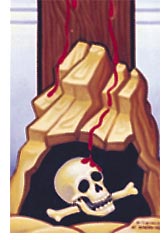 At the foot of the Cross we find the skull and bones of Adam, the First Man. Tradition tells us that Golgotha was called the Place of the Skull not because the hill looked like a human skull, but because the bones of Adam had been brought and buried there by the descendants of Noah. When the Lord died, a great earthquake split apart the rocks, and the blood of the Lord flowed down from the Cross and on to the bones of Adam, indicating the remission of sins made possible to the whole human race. Pilgrims to the Church of the Holy Sepulchre in Jerusalem can put their hands down into the very cavity where Adam’s bones were awaiting the redeeming blood of Christ.
At the foot of the Cross we find the skull and bones of Adam, the First Man. Tradition tells us that Golgotha was called the Place of the Skull not because the hill looked like a human skull, but because the bones of Adam had been brought and buried there by the descendants of Noah. When the Lord died, a great earthquake split apart the rocks, and the blood of the Lord flowed down from the Cross and on to the bones of Adam, indicating the remission of sins made possible to the whole human race. Pilgrims to the Church of the Holy Sepulchre in Jerusalem can put their hands down into the very cavity where Adam’s bones were awaiting the redeeming blood of Christ.
Truly, as Saint Basil the Great wrote, “With a soundless voice the icons teach those who behold them.”